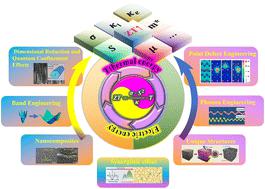当前位置:
X-MOL 学术
›
J. Mater. Chem. A
›
论文详情
Our official English website, www.x-mol.net, welcomes your feedback! (Note: you will need to create a separate account there.)
Advancements in thermoelectric materials: optimization strategies for enhancing energy conversion
Journal of Materials Chemistry A ( IF 10.7 ) Pub Date : 2024-08-23 , DOI: 10.1039/d4ta03666b Haiwei Han 1 , Lijun Zhao 1 , Xinmeng Wu 1 , Bin Zuo 1 , Shunuo Bian 1 , Tao Li 1 , Xinyue Liu 1 , Yaohong Jiang 1 , Chunyan Chen 1 , Jiali Bi 1 , Junhua Xu 1 , Lihua Yu 1
Journal of Materials Chemistry A ( IF 10.7 ) Pub Date : 2024-08-23 , DOI: 10.1039/d4ta03666b Haiwei Han 1 , Lijun Zhao 1 , Xinmeng Wu 1 , Bin Zuo 1 , Shunuo Bian 1 , Tao Li 1 , Xinyue Liu 1 , Yaohong Jiang 1 , Chunyan Chen 1 , Jiali Bi 1 , Junhua Xu 1 , Lihua Yu 1
Affiliation

|
Thermoelectric materials are a highly promising category of energy conversion materials. In this paper, we present a multitude of approaches to enhance the efficacy of these materials. The review begins with an introduction to the fundamental concept of the thermoelectric figure of merit (ZT), a key parameter for assessing the performance of thermoelectric materials, as well as theories of electrical and thermal transport, which lay the groundwork for understanding and improving the performance of thermoelectric materials. Subsequently, this paper delves into several typical optimization strategies, including the enhancement of material performance through low-dimensionalization and quantum confinement effects, with detailed discussions on two-dimensional, one-dimensional, and zero-dimensional materials. The role of point defect engineering in modulating material properties and the significance of nano-composite materials in enhancing thermoelectric performance are also explored. Band engineering, an effective optimization technique, offers multiple possibilities for enhancing thermoelectric performance through the adjustment of carrier effective mass, utilization of resonance states, band degeneracy, band convergence, and bandgap tuning. Additionally, the application of phonon engineering in reducing thermal conductivity and improving thermoelectric conversion efficiency is highlighted. Discussions on special structures such as textures, single crystals, core–shell structures, and porous structures, as well as symmetry control strategies, highlight the importance of microstructural control in optimizing thermal conductivity. Consequently, the review explores the significance of the synergistic effects of different strategies, noting that an integrated application of these strategies can maximize the performance of thermoelectric materials. The use of materials genomics and machine learning in screening highly potential thermoelectric materials is also highlighted. Finally, the paper addresses the challenges and developments related to the stability, scalability, sustainability, and integration of thermoelectric materials with other systems. Overall, this article summarizes a series of optimization strategies for thermoelectric materials, providing valuable references and inspiration for researchers in the field, with the aim of further advancing the science of thermoelectric materials.
中文翻译:

热电材料的进展:增强能量转换的优化策略
热电材料是一类极具前景的能量转换材料。在本文中,我们提出了多种增强这些材料功效的方法。综述首先介绍了热电品质因数( ZT )的基本概念,这是评估热电材料性能的关键参数,以及电和热输运理论,为理解和改进热电性能奠定了基础。热电材料的性能。随后,本文深入研究了几种典型的优化策略,包括通过低维化和量子限制效应增强材料性能,并对二维、一维和零维材料进行了详细讨论。还探讨了点缺陷工程在调节材料性能中的作用以及纳米复合材料在增强热电性能方面的重要性。能带工程是一种有效的优化技术,通过调整载流子有效质量、利用共振态、能带简并、能带收敛和带隙调谐,为增强热电性能提供了多种可能性。此外,还强调了声子工程在降低热导率和提高热电转换效率方面的应用。对织构、单晶、核壳结构和多孔结构等特殊结构以及对称控制策略的讨论强调了微观结构控制在优化导热性方面的重要性。 因此,该综述探讨了不同策略协同效应的重要性,指出这些策略的综合应用可以最大限度地提高热电材料的性能。还强调了材料基因组学和机器学习在筛选高潜力热电材料中的应用。最后,本文讨论了与热电材料的稳定性、可扩展性、可持续性以及与其他系统集成相关的挑战和发展。总体而言,本文总结了一系列热电材料的优化策略,为该领域的研究人员提供了有价值的参考和启发,旨在进一步推进热电材料科学的发展。
更新日期:2024-08-23
中文翻译:

热电材料的进展:增强能量转换的优化策略
热电材料是一类极具前景的能量转换材料。在本文中,我们提出了多种增强这些材料功效的方法。综述首先介绍了热电品质因数( ZT )的基本概念,这是评估热电材料性能的关键参数,以及电和热输运理论,为理解和改进热电性能奠定了基础。热电材料的性能。随后,本文深入研究了几种典型的优化策略,包括通过低维化和量子限制效应增强材料性能,并对二维、一维和零维材料进行了详细讨论。还探讨了点缺陷工程在调节材料性能中的作用以及纳米复合材料在增强热电性能方面的重要性。能带工程是一种有效的优化技术,通过调整载流子有效质量、利用共振态、能带简并、能带收敛和带隙调谐,为增强热电性能提供了多种可能性。此外,还强调了声子工程在降低热导率和提高热电转换效率方面的应用。对织构、单晶、核壳结构和多孔结构等特殊结构以及对称控制策略的讨论强调了微观结构控制在优化导热性方面的重要性。 因此,该综述探讨了不同策略协同效应的重要性,指出这些策略的综合应用可以最大限度地提高热电材料的性能。还强调了材料基因组学和机器学习在筛选高潜力热电材料中的应用。最后,本文讨论了与热电材料的稳定性、可扩展性、可持续性以及与其他系统集成相关的挑战和发展。总体而言,本文总结了一系列热电材料的优化策略,为该领域的研究人员提供了有价值的参考和启发,旨在进一步推进热电材料科学的发展。





































 京公网安备 11010802027423号
京公网安备 11010802027423号